roof OPEL CORSA E 2019 Manual user
[x] Cancel search | Manufacturer: OPEL, Model Year: 2019, Model line: CORSA E, Model: OPEL CORSA E 2019Pages: 231, PDF Size: 6.87 MB
Page 38 of 231
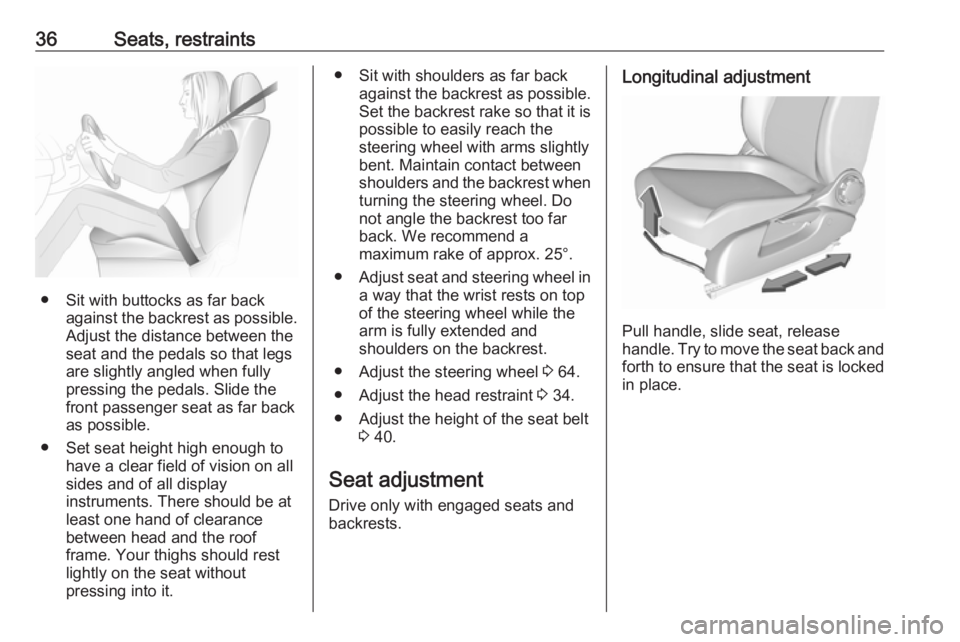
36Seats, restraints
● Sit with buttocks as far backagainst the backrest as possible.
Adjust the distance between the
seat and the pedals so that legs
are slightly angled when fully
pressing the pedals. Slide the
front passenger seat as far back
as possible.
● Set seat height high enough to have a clear field of vision on all
sides and of all display
instruments. There should be at
least one hand of clearance
between head and the roof
frame. Your thighs should rest
lightly on the seat without
pressing into it.
● Sit with shoulders as far back against the backrest as possible.
Set the backrest rake so that it is possible to easily reach the
steering wheel with arms slightly
bent. Maintain contact between
shoulders and the backrest when
turning the steering wheel. Do
not angle the backrest too far
back. We recommend a
maximum rake of approx. 25°.
● Adjust seat and steering wheel in
a way that the wrist rests on top
of the steering wheel while the
arm is fully extended and
shoulders on the backrest.
● Adjust the steering wheel 3 64.
● Adjust the head restraint 3 34.
● Adjust the height of the seat belt 3 40.
Seat adjustment
Drive only with engaged seats and
backrests.Longitudinal adjustment
Pull handle, slide seat, release
handle. Try to move the seat back and forth to ensure that the seat is locked
in place.
Page 49 of 231
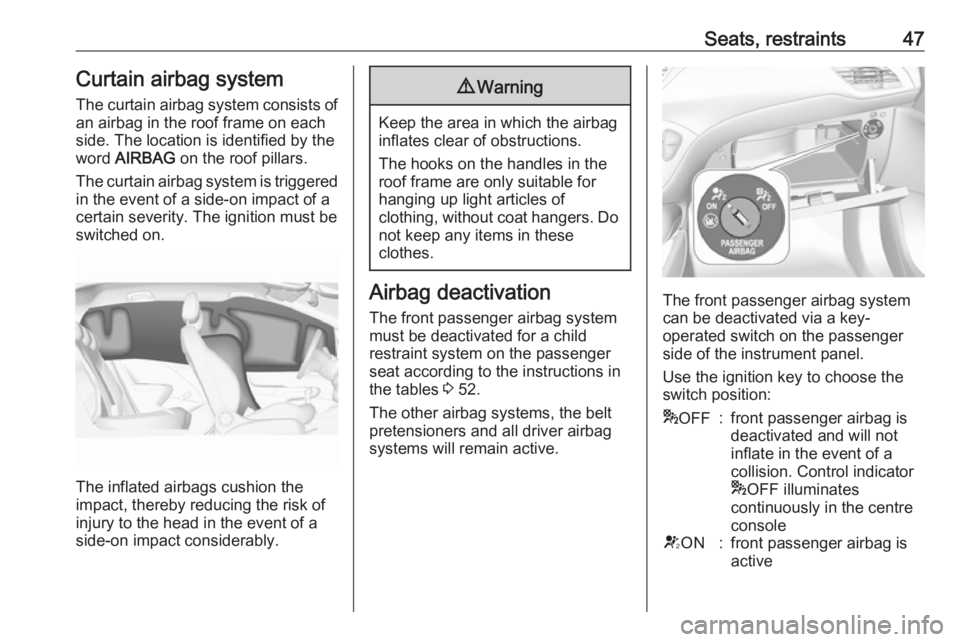
Seats, restraints47Curtain airbag system
The curtain airbag system consists of an airbag in the roof frame on each
side. The location is identified by the
word AIRBAG on the roof pillars.
The curtain airbag system is triggered in the event of a side-on impact of a
certain severity. The ignition must be
switched on.
The inflated airbags cushion the
impact, thereby reducing the risk of
injury to the head in the event of a
side-on impact considerably.
9 Warning
Keep the area in which the airbag
inflates clear of obstructions.
The hooks on the handles in the
roof frame are only suitable for
hanging up light articles of
clothing, without coat hangers. Do not keep any items in these
clothes.
Airbag deactivation
The front passenger airbag system must be deactivated for a child
restraint system on the passenger
seat according to the instructions in
the tables 3 52.
The other airbag systems, the belt
pretensioners and all driver airbag
systems will remain active.The front passenger airbag system can be deactivated via a key-
operated switch on the passenger
side of the instrument panel.
Use the ignition key to choose the
switch position:
* OFF:front passenger airbag is
deactivated and will not
inflate in the event of a
collision. Control indicator
* OFF illuminates
continuously in the centre
consoleV ON:front passenger airbag is
active
Page 57 of 231
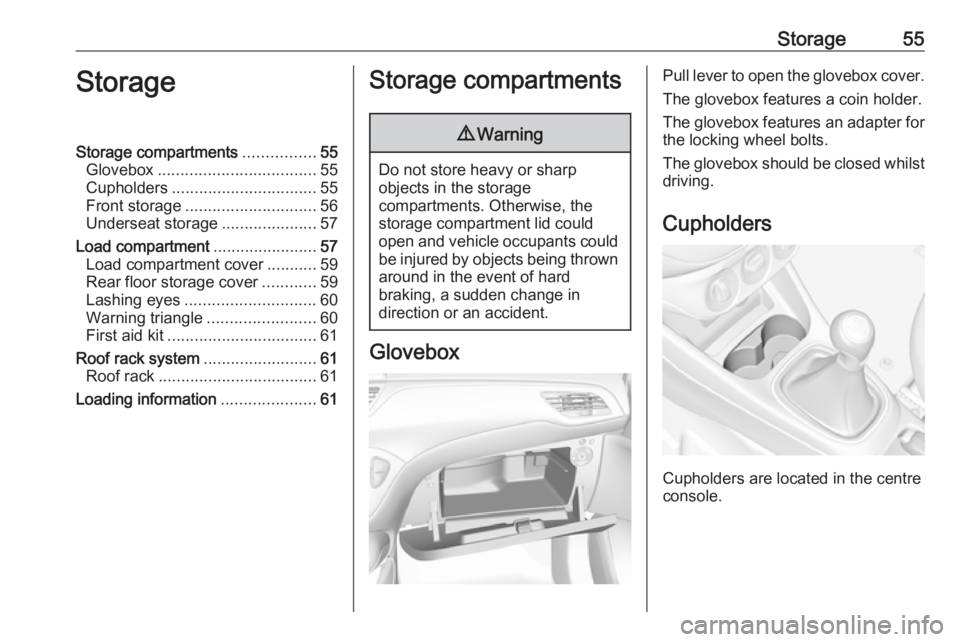
Storage55StorageStorage compartments................55
Glovebox ................................... 55
Cupholders ................................ 55
Front storage ............................. 56
Underseat storage .....................57
Load compartment .......................57
Load compartment cover ...........59
Rear floor storage cover ............59
Lashing eyes ............................. 60
Warning triangle ........................60
First aid kit ................................. 61
Roof rack system .........................61
Roof rack ................................... 61
Loading information .....................61Storage compartments9Warning
Do not store heavy or sharp
objects in the storage
compartments. Otherwise, the
storage compartment lid could
open and vehicle occupants could be injured by objects being thrown
around in the event of hard
braking, a sudden change in
direction or an accident.
Glovebox
Pull lever to open the glovebox cover.
The glovebox features a coin holder.
The glovebox features an adapter for
the locking wheel bolts.
The glovebox should be closed whilst driving.
Cupholders
Cupholders are located in the centre
console.
Page 63 of 231

Storage61First aid kit
Stow the first-aid kit in the
compartment in the left wall of the
load compartment.
To open the compartment, disengage cover and open it.
Roof rack system
Roof rack For safety reasons and to avoid
damage to the roof, the vehicle
approved roof rack system is
recommended. For further
information contact your workshop.
Follow the installation instructions
and remove the roof rack when not in
use.
Push covers for concealing roof rack
mounts down and push backwards.
Attach roof rack at appropriate points, see enclosed roof rack system
instructions.
Loading information
● Heavy objects in the load compartment should be placed
against the seat backrests.
Ensure that the backrests are
securely engaged. If objects can
be stacked, heavier objects
should be placed at the bottom.
● Prevent sliding of loose objects by securing them with straps
attached to the lashing eyes
3 60.
Page 64 of 231
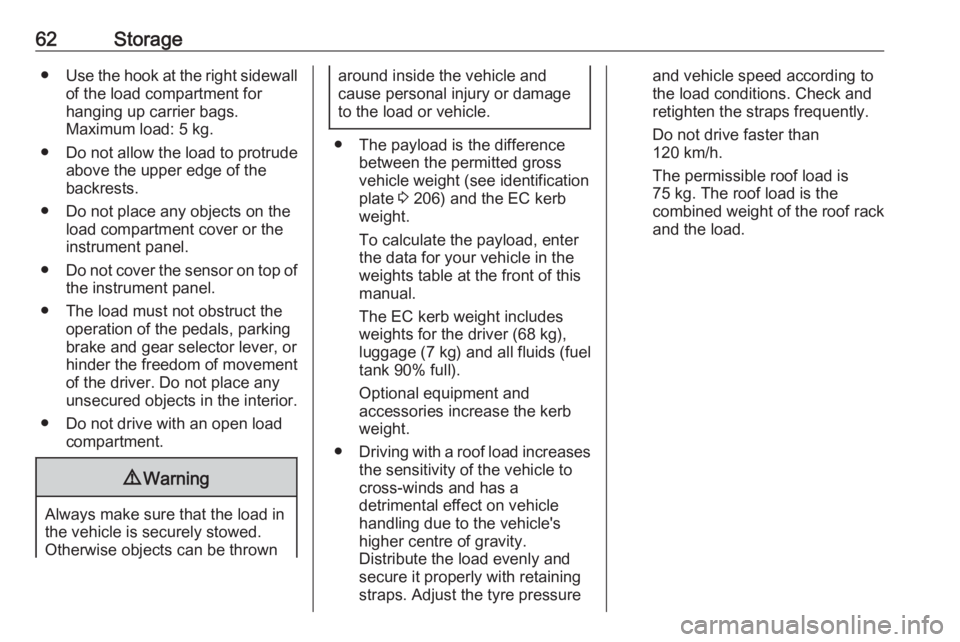
62Storage●Use the hook at the right sidewall
of the load compartment for
hanging up carrier bags.
Maximum load: 5 kg.
● Do not allow the load to protrude above the upper edge of the
backrests.
● Do not place any objects on the load compartment cover or theinstrument panel.
● Do not cover the sensor on top of
the instrument panel.
● The load must not obstruct the operation of the pedals, parking
brake and gear selector lever, or
hinder the freedom of movement of the driver. Do not place any
unsecured objects in the interior.
● Do not drive with an open load compartment.9Warning
Always make sure that the load in
the vehicle is securely stowed.
Otherwise objects can be thrown
around inside the vehicle and
cause personal injury or damage
to the load or vehicle.
● The payload is the difference between the permitted gross
vehicle weight (see identification
plate 3 206) and the EC kerb
weight.
To calculate the payload, enter
the data for your vehicle in the
weights table at the front of this
manual.
The EC kerb weight includes
weights for the driver (68 kg),
luggage (7 kg) and all fluids (fuel
tank 90% full).
Optional equipment and
accessories increase the kerb
weight.
● Driving with a roof load increases
the sensitivity of the vehicle to
cross-winds and has a
detrimental effect on vehicle
handling due to the vehicle's
higher centre of gravity.
Distribute the load evenly and secure it properly with retaining
straps. Adjust the tyre pressure
and vehicle speed according to
the load conditions. Check and
retighten the straps frequently.
Do not drive faster than
120 km/h.
The permissible roof load is
75 kg. The roof load is the
combined weight of the roof rack and the load.
Page 201 of 231

Vehicle care199If using a car wash, comply with the
car wash manufacturer's instructions.
The windscreen wiper and rear
window wiper must be switched off.
Remove antenna and external
accessories such as roof racks etc.
If you wash your vehicle by hand,
make sure that the insides of the
wheel housings are also thoroughly
rinsed out.
Clean edges and folds on opened
doors and the bonnet as well as the
areas they cover.
Clean bright metal mouldings with a
cleaning solution approved for
aluminium to avoid damages.Caution
Always use a cleaning agent with
a pH value of 4 to 9.
Do not use cleaning agents on hot surfaces.
Have the door hinges of all doors
greased by a workshop.
Do not clean the engine compartment with a steam-jet or high-pressure jet
cleaner.
Thoroughly rinse and leather-off the vehicle. Rinse leather frequently. Use
separate leathers for painted and
glass surfaces: remnants of wax on
the windows will impair vision.
Do not use hard objects to remove
spots of tar. Use tar removal spray on
painted surfaces.
Exterior lights
Headlight and other light covers are
made of plastic. Do not use any
abrasive or caustic agents, do not use
an ice scraper, and do not clean them
dry.
Polishing and waxing
Wax painted parts of the vehicle
regularly (at the latest when water no longer beads). Otherwise, the
paintwork will dry out.
Polishing is necessary only if the paint
has become dull or if solid deposits
have become attached to it.
Paintwork polish with silicone forms a
protective film, making waxing
unnecessary.Unpainted plastic body parts must not
be treated with wax or polishing
agents.
Matt filmed body parts or decor tapes must not be polished, to avoid
gleaming. Do not use hot wax
programmes in automatic car washes if the vehicle is equipped with theseparts.
Matt painted decor parts, e.g. mirror
housing cover, must not be polished.
Otherwise these parts would become agleam or the colour would be
dissolved.
Windows and wiper blades Switch off wipers before handling intheir areas.
Use a soft lint-free cloth or chamois
leather together with window cleaner
and insect remover.
When cleaning the rear window from
inside, always wipe in parallel to the
heating element to prevent damage.
Page 205 of 231
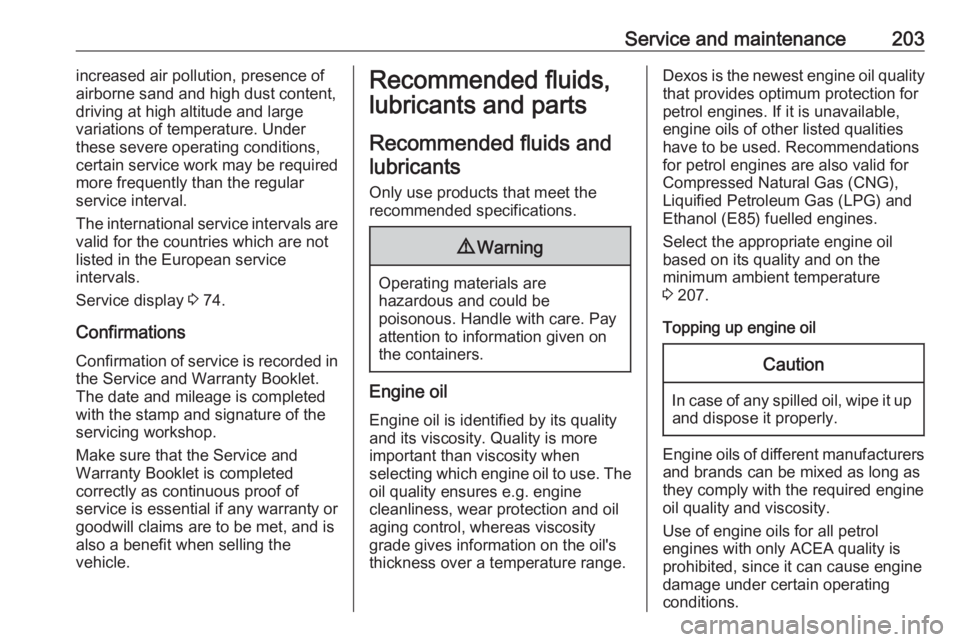
Service and maintenance203increased air pollution, presence of
airborne sand and high dust content,
driving at high altitude and large
variations of temperature. Under
these severe operating conditions,
certain service work may be required more frequently than the regularservice interval.
The international service intervals are
valid for the countries which are not
listed in the European service
intervals.
Service display 3 74.
Confirmations
Confirmation of service is recorded in the Service and Warranty Booklet.
The date and mileage is completed
with the stamp and signature of the
servicing workshop.
Make sure that the Service and
Warranty Booklet is completed
correctly as continuous proof of
service is essential if any warranty or goodwill claims are to be met, and is
also a benefit when selling the
vehicle.Recommended fluids,
lubricants and parts
Recommended fluids andlubricants
Only use products that meet the
recommended specifications.9 Warning
Operating materials are
hazardous and could be
poisonous. Handle with care. Pay
attention to information given on
the containers.
Engine oil
Engine oil is identified by its quality
and its viscosity. Quality is more
important than viscosity when
selecting which engine oil to use. The oil quality ensures e.g. engine
cleanliness, wear protection and oil
aging control, whereas viscosity
grade gives information on the oil's
thickness over a temperature range.
Dexos is the newest engine oil quality
that provides optimum protection for
petrol engines. If it is unavailable,
engine oils of other listed qualities
have to be used. Recommendations
for petrol engines are also valid for
Compressed Natural Gas (CNG),
Liquified Petroleum Gas (LPG) and
Ethanol (E85) fuelled engines.
Select the appropriate engine oil
based on its quality and on the
minimum ambient temperature
3 207.
Topping up engine oilCaution
In case of any spilled oil, wipe it up and dispose it properly.
Engine oils of different manufacturersand brands can be mixed as long as
they comply with the required engine
oil quality and viscosity.
Use of engine oils for all petrol
engines with only ACEA quality is
prohibited, since it can cause engine
damage under certain operating
conditions.
Page 229 of 231
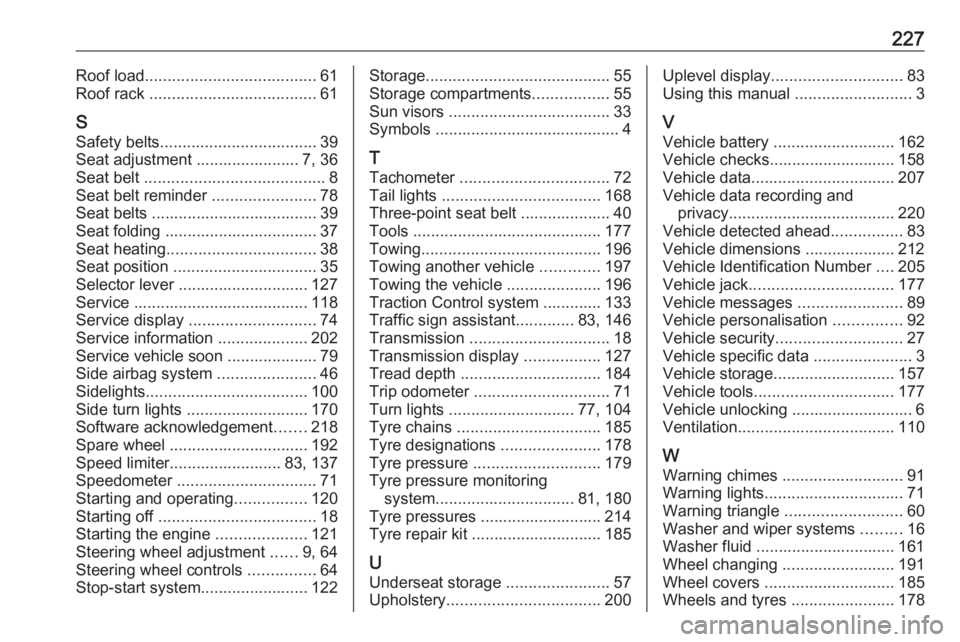
227Roof load...................................... 61
Roof rack ..................................... 61
S Safety belts ................................... 39
Seat adjustment ....................... 7, 36
Seat belt ........................................ 8
Seat belt reminder .......................78
Seat belts ..................................... 39
Seat folding .................................. 37
Seat heating ................................. 38
Seat position ................................ 35
Selector lever ............................. 127
Service ....................................... 118
Service display ............................ 74
Service information ....................202
Service vehicle soon .................... 79
Side airbag system ......................46
Sidelights .................................... 100
Side turn lights ........................... 170
Software acknowledgement .......218
Spare wheel ............................... 192
Speed limiter......................... 83, 137
Speedometer ............................... 71
Starting and operating ................120
Starting off ................................... 18
Starting the engine ....................121
Steering wheel adjustment ......9, 64
Steering wheel controls ...............64
Stop-start system........................ 122Storage ......................................... 55
Storage compartments .................55
Sun visors .................................... 33
Symbols ......................................... 4
T
Tachometer ................................. 72
Tail lights ................................... 168
Three-point seat belt .................... 40
Tools .......................................... 177
Towing ........................................ 196
Towing another vehicle .............197
Towing the vehicle .....................196
Traction Control system ............. 133
Traffic sign assistant .............83, 146
Transmission ............................... 18
Transmission display .................127
Tread depth ............................... 184
Trip odometer .............................. 71
Turn lights ............................ 77, 104
Tyre chains ................................ 185
Tyre designations ......................178
Tyre pressure ............................ 179
Tyre pressure monitoring system ............................... 81, 180
Tyre pressures ........................... 214
Tyre repair kit ............................. 185
U Underseat storage .......................57
Upholstery .................................. 200Uplevel display............................. 83
Using this manual ..........................3
V Vehicle battery ........................... 162
Vehicle checks............................ 158
Vehicle data ................................ 207
Vehicle data recording and privacy ..................................... 220
Vehicle detected ahead ................83
Vehicle dimensions .................... 212
Vehicle Identification Number ....205
Vehicle jack ................................ 177
Vehicle messages .......................89
Vehicle personalisation ...............92
Vehicle security ............................ 27
Vehicle specific data ......................3
Vehicle storage ........................... 157
Vehicle tools ............................... 177
Vehicle unlocking ........................... 6 Ventilation ................................... 110
W
Warning chimes ........................... 91
Warning lights ............................... 71
Warning triangle .......................... 60
Washer and wiper systems .........16
Washer fluid ............................... 161
Wheel changing .........................191
Wheel covers ............................. 185
Wheels and tyres .......................178